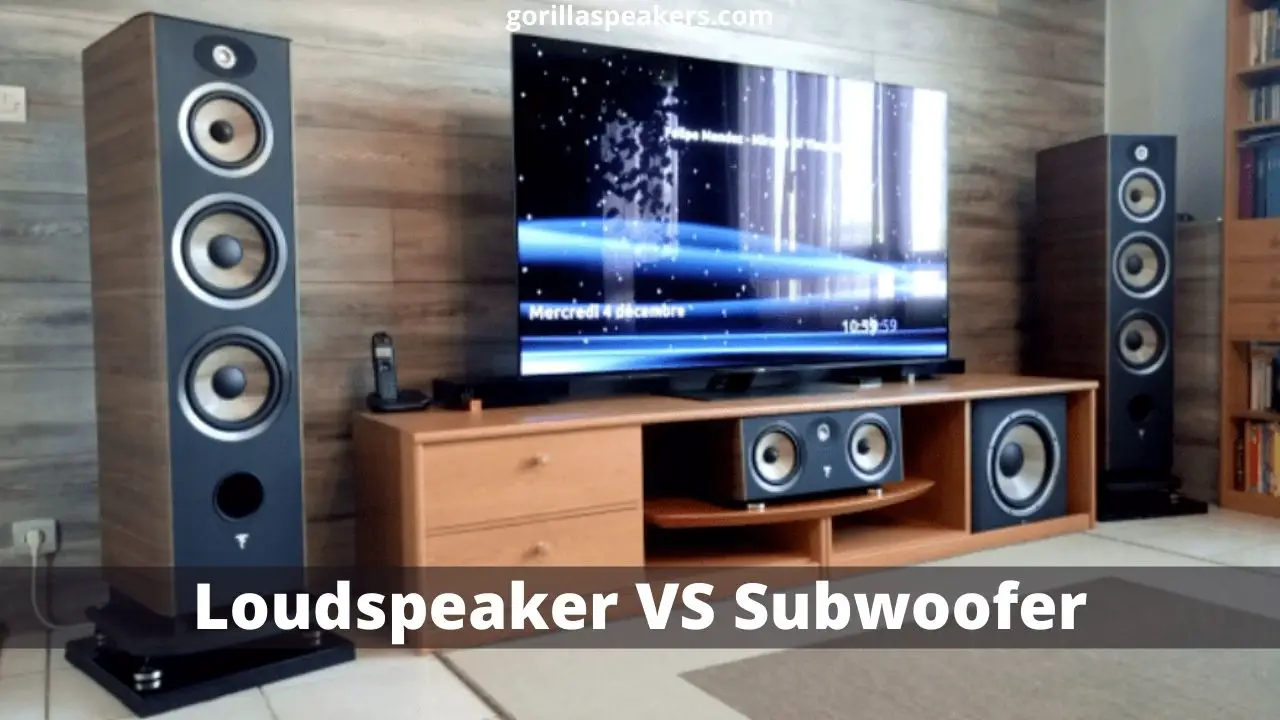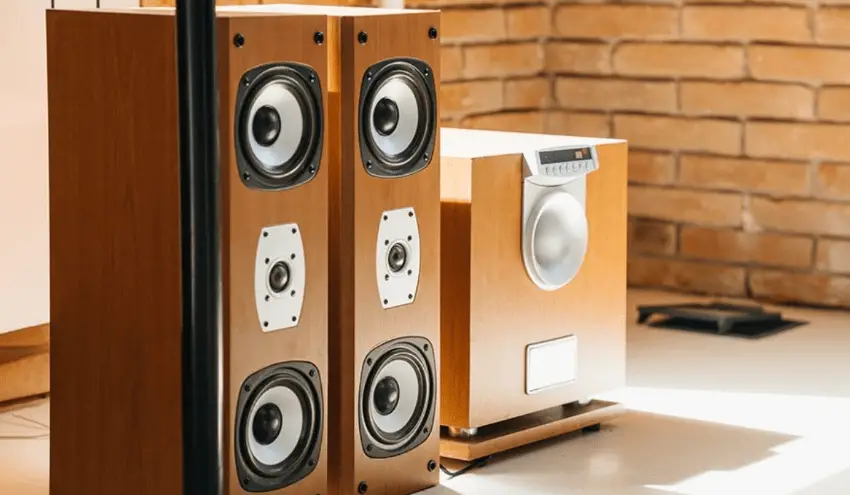A subwoofer and a loudspeaker both are transducers, The main difference between them is the frequency range they cover.
Lower frequencies, also known as sub-bass response, are handled by subwoofers, while mid- and high-range frequencies are handled by loud speakers.
Don’t worry if you’re unsure which of the two you should choose. This article discusses how these two differ and which one is best suited for which application, and everything that you should know about subwoofers and loudspeakers.
So, without any further ado Let’s begin!
Loudspeaker VS Subwoofer: Comparison Table
Here’s our take on the subwoofer vs loudspeaker debate.
Various sizes of speakers manage different ranges better, just like tenors, basses, sopranos, and altos in a choir. This is why, in most cases, a speaker system includes more than one actual speaker.
To achieve a quality sound system, particularly for use by singers, bands, and DJs, you will typically have a setup that includes Loudspeakers and subwoofers, as well as tweeters, mid-ranges, and woofers, as they each manage a different range of notes and sounds and when used together, cover the entire range of sound.
| Parameters of Comparison | Loud Speaker | Subwoofer |
| What is it? | A Loud Speaker refers to an electro-acoustic transducer. It converts an electrical signal into sound. | A specialized type of woofer. A subwoofer is designed for one job, to produce lower frequencies and the frequency range of the sub often depends on the price. |
| Frequency | The frequency range covered is 20 Hz to 20,000 Hz | The range of frequency covered is 20Hz to 200Hz. |
| Use | Loud Speakers are widely used in radio/tape recorder, stereo system, black and white and color TV receivers, public address system, musical systems for reproduction of sound. | The subwoofer fits better when there is a demand for the best quality sound. A subwoofer (or “sub”) focuses on producing the lower frequencies within music, known as the bass and sub-bass, amplified through the woofer. |
| Frequency range | Loud Speakers covers a wider range of frequencies. | The subwoofer covers a narrower range of frequency. |
| Portability | Not Portable. | Not portable. |
| Size | Large in size | Comparatively larger. |
Loudspeaker VS Subwoofer: How Do They Work?
In a Subwoofer, When an amplifier sends audio signals to a subwoofer, an electric current flows through the voice coil, which generates a magnetic field that pulls and pushes the voice coil against the magnetic gap.
The voice coil moves upward and downward in response to this alternating current, producing sound.
The subwoofer amplifies the current and transforms it to sound by using a magnetic coil that causes the cone of the driver to vibrate. As a result of this vibration, low-frequency sound waves are emitted into the air.
Subwoofers are linked to a receiver or preamplifier. The system receives low frequency (usually 20 Hz to 100 Hz) signals to the subwoofer via electrical current, made reference to on soundtracks as low-frequency effects (LFE).
The subwoofer enhances the current and transforms it to sound via a magnetic coil, which causes vibration of the driver’s cone. This vibration causes low-frequency sound waves to be transmitted through the air.
In a Loudspeaker, The alternating current supplied to the loudspeaker produces sound waves in the following manner: a current in the coil produces a magnetic field.
When the magnetic field comes into contact with the permanent magnet, it generates a force that pushes the cone outwards. The current is redirected in the reverse direction.
Loudspeakers generate mechanical energy by conversion of electrical energy (motion). Mechanical energy compresses air and transforms motion into sound energy or sound pressure level (SPL).
When the electric current goes through a wire coil, it creates a magnetic field. The magnetic field direction of the electromagnet coil rapidly changes as electricity pulses pass through it, starting to cause the cone to vibrate.
These vibrations are amplified by the cone structure, which sends sound waves into the surrounding atmosphere and towards your ears. That is how sound is produced by a loudspeaker.
Loudspeaker VS Subwoofer: Functions
A subwoofer (or “sub”) aims at producing lower frequencies in music, known as bass and sub-bass, which are amplified by the woofer.
While regular speakers permit you to listen to the bass, a subwoofer allows you to feel it. A subwoofer may be a wonderful addition to your sound system, depending on the devices you already have.
Subs relieve your speakers of the strain of reproducing the audio’s full sound, allowing you to not only hear but also feel how a filmmaker or creator designed for you to experience their work.
A loudspeaker In sound reproduction, also known as a speaker, is a device that converts electrical energy into acoustical signal energy that is reflected back into a room or open air.
Loudspeakers use the motor effect. Different versions of an electric current cause variation in the magnetic field, which are created by an electromagnet in these devices.
This causes a cone to move, causing pressure fluctuations in the air and the formation of sound waves.
Loudspeakers, which are one of the most common output devices, are used to attach to a computer to generate sound.
Some speakers are developed to function with any type of sound system, while others are only compatible with computers.
Loudspeaker VS Subwoofer: Design
- Subwoofer enclosures have been designed in a variety of ways, including bass reflex (with a port or vent), to use a subwoofer and one or more passive radiator speakers in the enclosure, acoustic suspension (sealed enclosure), infinite baffle, horn-loaded, tapped horn, transmission line, and bandpass.
- The basic design of a loudspeaker consists of a suspension lightweight cone connected to an electromagnet (usually a coil of copper wire), which is permanently positioned in front of another magnet.
Loudspeaker VS Subwoofer: Types
Subwoofers:
- Active subwoofers
- Passive Subwoofers
Loudspeakers:
- Horn Loudspeakers
- Moving Coil Loudspeakers
- Electrostatic Loudspeakers
- Bending Wave Loudspeakers
What Are Subwoofers And Loudspeakers?
A subwoofer, which is also known as a sub, is a woofer or a loudspeaker intended to reproduce low-pitched audio frequencies, called as bass.
Because they focus on lower frequencies, Subs can provide consistent bass for most media and allow the amount of the bass line in music to be massively increased.
Active subwoofers and passive subwoofers are the two types of subwoofers.
An active subwoofer typically includes an amplifier, whereas a passive subwoofer requires an external amplifier and consists of only the subwoofer driver and enclosure.
Subwoofer Upsides
- Adding an active subwoofer improves the midrange sound, provides deeper bass and minimizes strain on your audio system.
- The main speakers are not required to play low-frequency sounds. That’s why, the overall audio quality is improved significantly.
- The low-frequency driver relieves a lot of strain on the main speakers, allowing them to play at higher volumes while maintaining clarity.
- Because the sub and main speakers share a distinct variety of sounds, they sound even better than a full-range speaker.
Subwoofer Downsides
- Many subwoofers are poorly designed, and as a consequence, they frequently come with numerous complications.
- Subwoofers cannot be used in isolation. They must always be combined with speakers.
On the other side, An electro-acoustic transducer is referred to as a Loudspeaker. It transforms an electrical signal into sound.
The inherent working principle of a loudspeaker (or speaker) is that variations in an electric signal cause the device to move in sync with it, causing sound waves to propagate through the medium of either air or water.
The speakers are the source of the most distortion and audible variances, so they play a significant role in trying to compare audio systems.
The main distinction between subwoofers and speakers is their frequency range. While subwoofers are used in the lowest part of the frequency range and are ideal for bass sounds, speakers have no such limitations and can deliver high frequencies, such as the mid and treble range, to excellence.
Loudspeakers Upsides
- They can produce decent sound even without a subwoofer.
- When compared to subwoofers, speakers are less expensive.
Loudspeakers Downsides
- They are unable to produce deep bass.
The Primary Distinctions Between Subwoofer And Loudspeaker
Regular speakers will not be able to handle music with a lot of bass and sub-bass. Loudspeakers are used in computers and televisions because they focus on the mid and high-range frequencies.
The components are ideal for voices, but if you listen to music, you will notice something is missing.
A subwoofer will be required if you really want to hear the lower frequencies. For a more balanced sound, a subwoofer is intended only to generate the deep bass found in most music genres.
One important distinction to remember is that speakers can be used without subwoofers, but subs cannot be used without speakers.
Do Subwoofers Improve The Sound Of Loudspeakers?
When subwoofers are often used in conjunction with Loudspeakers, the sound quality improves immediately. It’s because the subwoofers relieve the speakers of the burden of dealing with lower frequencies.
This allows your speakers to focus on the mid-and high-range frequencies for which they were designed.
With a great sub, the system’s dynamics rock harder, and the depth and spaciousness of the soundstage improve.
A well-matched subwoofer will dramatically improve your system’s overall sound, and going to add the right subwoofer will yield better results than upgrading electronics.
Which Is More Effective? Subwoofer or Loudspeaker?
Loudspeakers differ from subwoofers in that subwoofers are more powerful and can manage lower frequencies ranging from 20Hz to 200Hz while loud speakers play mid and high range frequencies.
Overall, when purchasing a home theater system, you should pay close attention to the type of speakers you purchase to ensure that they work in tandem with your subwoofer.
The overall audio quality has improved across all frequencies. Because of the subwoofer’s stress reduction on your speakers, you can turn up the volume without distortion.
Because the sub focuses on a different frequency range than the speakers, the audio is crisper and more precise than with full-range speakers.
Frequently Asked Questions
Can A Woofer Also Function As a Subwoofer?
The short answer is that you can. However, it would be more appropriate to refer to it as a woofer in this case. Since the same driver is placed in its own box with its own amplifier, it can be referred to as a subwoofer because it is an LFE.
Subwoofer drivers are frequently designed to operate at lower frequencies than typical woofers.
What Distinguishes A Speaker From A Subwoofer?
Subwoofers are composed of one or more woofers mounted in a loudspeaker enclosure capable of withstanding air pressure while resisting deflections (often made of wood).
Passive subwoofers are powered by an external amplifier and include a subwoofer driver and enclosure. Active subwoofers have an amplifier built-in.
Is It Better To Have A Woofer or A Subwoofer?
A woofer is made up of one speaker driver housed inside an enclosure. Considering that woofers are overall low speakers, you should go with a high-quality option to get the music or audio that you prefer by choosing a subwoofer.
Conclusion
To summarize, acknowledging how a subwoofer and loud speaker works is critical because it informs you of what to look for when making a purchase.
I’ve gone over each component in depth in this guide to make you understand their role and responsibilities.
Lower frequencies will be deeper and clearer while using a subwoofer, while mid and high frequencies would be clearer and louder using a loudspeaker.



